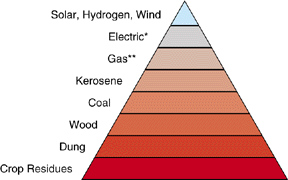

The intent of the science section is to share the concepts, monitoring information, and published scientific reports. Go to the Medical Effects section to learn how soot and combustion created pollution damages the body.
Sources of Fine Particulate Pollution (chart) compares the quantity of particulate matter produced by various fuels and sources. It shows the number of grams of fine soot produced in an hour by home heating devices, recreational petroleum wax sawdust logs (they may contain other garbage as fuel also) and transportation. For comparison we also added thirty cigarettes to the chart.

How Efficient is Solid Fuel? The Energy Pyramid : A concept in fuel cleanliness. (Thanks to Kirk Smith, Ph.D., University of CA, Berkeley.)
How does wood as a fuel compare with other sources in cleanliness? What quantity of the fuel does it take to heat the house or cook the meal or power the lights. Solid fuels or biomass fuels are less efficient than oil, natural gas or propane. It takes larger quantities of peat, wood, or coal to do the job and they will produce larger quantities of smoke when they are burned. Solid fuels produce dramatically less heat for the amount of fuel consumed and produce dramatically more pollution. When we use more efficient fuels we produce less pollution. It is as simple as that.
This has also been described as the energy ladder. The dirtiest fuels such as grass and animal dung are at the bottom rung. Going up the ladder, step by step with wood, then coal, until the next most efficient type of fuel is used. Dramatic reduction in pollution occurs when the next physical state, liquid kerosene is reached. Liquid fuel is less polluting than solid fuel. Natural gas and propane gas are dramatically less polluting than solid or liquid fuels. Electric energy produces no at site pollution although it's generation can produce pollution.
Wind, solar and hydropower are the cleanest forms of energy, as there is no combustion. Carrying the idea further, an Energy Pyramid symbolizes both quantity of fuel used and quantity of pollution produced going up the energy ladder. Say we do not know the number of grams that charcoal briquette combustion would produce. Charcoal briquettes are actually wood, initial combustion has burned off some of the start up pollutants. Thinking of the energy ladder we can place this cooking fuel in a pollution ranking because we know that it is in a solid form. To rephrase burning less efficient fuels like dung, wood, and coal create exponentially more soot than burning more efficient fuels.
The key word is burning. When anything is burned it creates toxic pollution.
There is an old adage, "The solution to pollution is dilution." If you burn anything you are at the epicenter of a self created pollution event.
The key is to avoid creating any more of a 'personal cloud' than absolutely necessary. Since the inside of your home can measure 70% of the aerosol levels outside your home, it behooves you to encourage your neighbors, and your community to make scientifically based combustion decisions that will protect human health, that is to encourage fuel use from the very top of the energy pyramid..
You cannot complain about factories, refineries, or tobacco smokers if you create an equal amount of pollution around yourself with wood heat, and other combustion habits.
Our problem as a society with a world population approaching 6.5 billion people, is that that ignorant people still live and continue to burn wood even when it is not necessary. People want abandon when it comes to combustion pleasures and compulsions, and none of the responsibility of the consequences.
Burning Issues update: May 12, 2007
